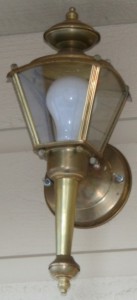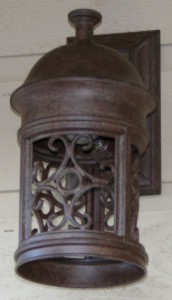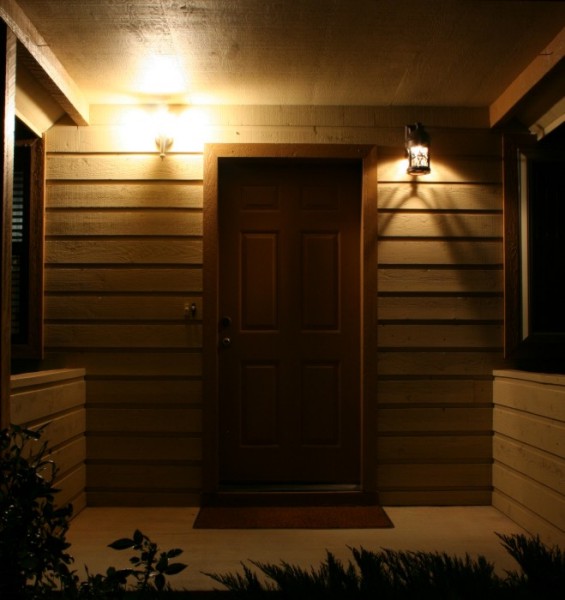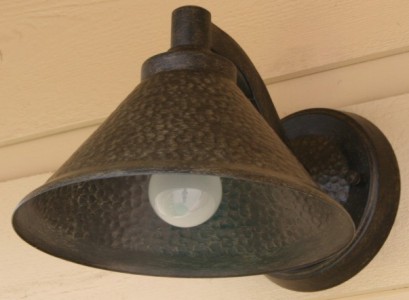
Neighbor-Friendly Lighting
Principles | Example | About

Tom Burrows
August 6, 2013
This article describes the upgrading of my house's existing high-glare exterior lighting to use low-glare fixtures that actually do a better job of illumination.
The old fixtures at the front of the house were of the type shown in Figure 1. A pair of these were located on either side of the front door. The purpose of fixtures here is to illuminate the entryway and the couple of steps leading up to it, as well as to indicate the location of the front door to visitors looking for the house.

Figure 1. Old, high-glare fixture. |

Figure 2. New, no-glare fixture. |
The main problem with the fixture shown in Figure 1 is that most of the light is directed not toward the subject (i.e., the steps) but sideways into people's eyes. This glare can knock out the night vision of people hundreds of feet away and make it difficult to see the ground they are walking on; and it can also reduce the peripheral night vision of a passing motorist for some time after they have driven by. In addition to this safety hazard, fixtures of this type brilliantly illuminate the bedrooms of neighbors who are trying to sleep. This type of fixture also shines a lot of waste light into the sky; and this particular fixture has substructure below the bulb that actually prevents it from shining straight downward—toward what it is supposed to illuminate.
I replaced both of these fixtures with new ones of a glare-free design, shown in Figure 2. This one is Minka-Lavery model 8281-61. This is a "full-cutoff" fixture whose bulb cannot be seen unless you are underneath it. (For this to work properly, they recommend an "appliance" bulb instead of a regular lamp bulb, which would protrude down too far.)
In order to provide a good before-and-after picture of the improvement, I took some night photos after replacing just one of the two fixtures, so that the old and new could be seen side-by-side (and photographed using one camera setting). The result is shown in Figure 3. It should go without saying that the new fixture is the one on the right.

|
|
Figure 3. Old and new fixtures at night, for comparison. |
The tremendous glare produced by the old fixture is obvious. The effect is actually much worse than can be seen in the photograph because the camera was saturated by the intensity of the glare. Looking more closely at the photograph, notice that the new glareless fixture actually casts more light on the walking surface so that the step can be seen more clearly. This is because it has no structure below the bulb to interfere with the illumination of the subject. Notice also that the new fixture shines no useless light upward. The glare off the entryway ceiling above the old fixture is light that would go up into the night sky if the ceiling weren't there.
Bad fixtures of the type shown in Figure 1 had also been used on each side of the garage doors. I replaced them with fixtures like that shown in Figure 4 (Minka-Lavery model 8101-138).

|
|
Figure 4. New low-glare fixture for the garage. |
These provide the proper amount of light for activities like loading a car parked in the driveway. This illumination is properly confined to just the driveway and, as with the other fixture, the bulb is tucked up inside and cannot be seen from the street.
It was very dismaying that all of the fixtures I saw in the local hardware and lighting stores were of high-glare designs. The new low-glare fixtures discussed in this article had to be special ordered.
I have been told that the city already has codes requiring non-glare, full-cutoff outdoor lighting. The fact that no fixtures of this type were available in local stores suggests that the code is not being enforced. High-glare street lights appearing north of the local Mall and in the local (redesigned) downtown area are also an indication that modern illumination engineering standards and recommendations are not being followed by local municipalities.
People using bad lighting will often say they need it in order to feel safe from criminals. But unless they are expecting an attack by parachutists, shining lights into the sky has no security value. And unless they are expecting attacks from gun emplacements in their neighbors' bedrooms, shining lights in this direction also serves no good purpose.
Neighbor-friendly outdoor lighting is not a matter of liberty vs. authority; it's a matter of common courtesy and avoiding pointless waste. The avoidance of glaring nuisance lighting requires only a little bit of thinking about what one is doing. Contrary to what some are suggesting, this does not require adoption of the no-lighting standard of North Korea or wide-scale abolition of night-time human activity.
I hope these notes will encourage more people to install neighbor-friendly lighting and that the information provided will save some time deciding what to do. A simple web search on the model numbers mentioned above will turn up retailers who carry appropriate fixtures.
An electronic copy of this article (and the rest of the Neighbor-Friendly Lighting website) is at neighborfriendlylighting.com.